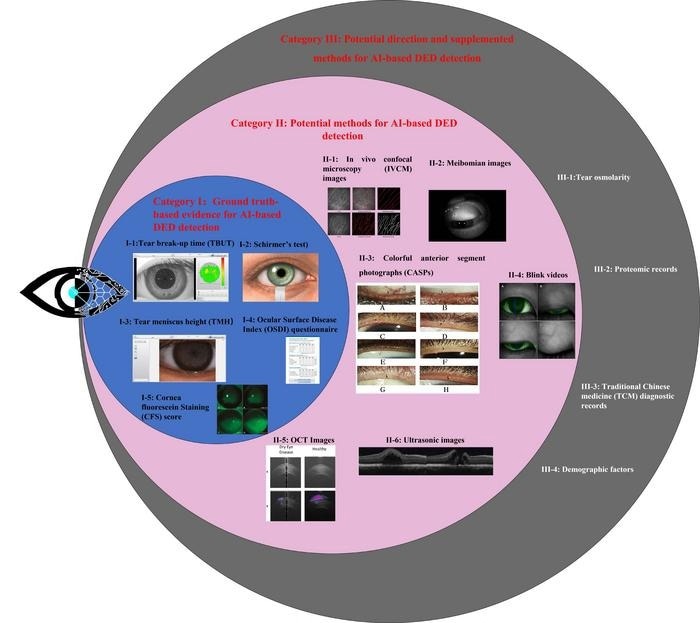Reviewed by Lexie CornerApr 24 2024
According to a study published in Big Data Mining and Analytics, researchers want to employ artificial intelligence (AI) to help in the early detection and diagnosis of Dry Eye Disease (DED). AI can make screening more accessible to individuals and could also help patients receive individualized therapy interventions.
 The blue circle represents ground truth-based evidence, the pink represents potential methods, and the gray area represents supplemental methods. Image Credit: Mini Han Wang, Zhuhai People’s Hospital, the Chinese University of Hong Kong.
The blue circle represents ground truth-based evidence, the pink represents potential methods, and the gray area represents supplemental methods. Image Credit: Mini Han Wang, Zhuhai People’s Hospital, the Chinese University of Hong Kong.
DED is one of the most common eye illnesses, affecting up to 30 % of the global population. This condition can impact various individuals and significantly reduce their overall quality of life. Early screening and prognosis are critical to the disease’s development in patients. However, this could prove challenging.
DED can impact a wide range of people, including those who wear contact lenses and cosmetics, stay up late, spend a lot of time staring at devices, and are above thirty years of age. The symptoms of this condition include dry eyes, irritation, stinging, tears, eye fatigue, and discomfort.
This disease has the potential to significantly affect a substantial section of the modern world's population. Here is where eye disease detection and the world of computer scientists and engineers could collaborate.
By addressing challenges, imparting insights, and delineating future research pathways, it contributes substantially to the advancement of ophthalmic disease detection through sophisticated technological modalities.
Mini Han Wang, Study Author and Researcher, City University of Macau
This AI-based disease detection system has seven facets. The first step is timely intervention through the AI screening process, followed by an accurate diagnosis. Another facet is the use of detailed surveys for DED using AI, which serves as a supporting concept to assure thoroughness and reliability throughout the process. A methodical strategy is used, as well as the integration of computer science and engineering with ophthalmology.
Then, criteria for DED detection must be developed and maintained for future researchers and practitioners, which will inevitably lead to improvement in the area. Finally, all of the research, methodology, and tools must be gathered so that academics, scholars, and practitioners have access to the most recent information accessible.
While ophthalmologists establish rules for the disease’s framework and diagnostic flags, AI does much of the heavy labor. Ideally, this AI would leverage images and videos captured from a user’s cell phone to reach consumers worldwide.
The AI can subsequently analyze these images and other risk variables in the patient's life to create a smart and well-informed diagnosis. AI is constantly learning and can aid further research by adding to predictive models for DED.
The application of AI detection for DED shows great potential, especially as the risk factors are frequently regular activities in the daily lives of numerous individuals. Further research is required to make detection technologies more accessible and accurate.
Wang added, “However, there are still challenges for engineers to select the diagnostic standards and combinations of different types of datasets. By using trustworthy algorithms, images, and videos captured from phones for accessibility purposes, a holistic approach to healthcare for early screening is possible.”
With continued testing and collaboration between engineers and ophthalmologists, this method of testing has a high potential for contributing to early detection of DED and subsequent therapeutic actions taken for the patient to reduce a worsening condition or recover some quality of life.
Mini Han Wang and Xiangrong Yu of the Zhuhai People’s Hospital with Mini Han Wang also of the Department of Ophthalmology and Visual Sciences at the Chinese University of Hong Kong, The Faculty of Data Sciences at City University of Macau and the Department of big data at the Zhuhai Institute of Advanced Technology at the Chinese Academy of Sciences, Lumin Xing of the First Affiliated Hospital of Shandong First Medical University, Yi Pan of the Shenzhen Institute of Advanced Technology Chinese Academy of Sciences, Feng Gu of the College of Staten Island at the City University of New York, Junbin Fang at the Department of Optoelectronic Engineering at Jinan University, Chi Pui Pang, Kelvin KL Chong, Carol Yim-Lui Cheung and Xulin Liao of the Department of Ophthalmology and Visual Sciences at The Chinese University of Hong Kong, Xiaoxiao Fang with the Zhuhai Aier Eye Hospital, Jie Yang of the College of Artificial Intelligence at Chongqing Industry and Trade Polytechnic, Ruoyu Zhou and Wenjian Liu with the Faculty of Data Science at City University of Macao, Xiaoshu Zhou with the Centre for Science and Technology Exchange and Cooperation between China and Portuguese-Speaking Countries, and Fengling Wang with the School of Artificial Intelligence at Hezhou Univeristy are the contributors of this study.
The study was made possible because of the support from the National Natural Science Foundation of China Natural, the Shenzhen Key Laboratory of Intelligent Bioinformatics, the Shenzhen Science and Technology Program, the Guangdong Basic and Applied Basic Research Foundation, the Zhuhai Technology and Research Foundation, the Project of Humanities and Social Science of MOE, the Science and Technology Research Program of Chongqing Municipal Education Commission and the Natural Science Foundation of Chongqing China.
Journal Reference:
Wang., M., H. et al. (2024) AI-Based Advanced Approaches and Dry Eye Disease Detection Based on Multi-Source Evidence: Cases, Applications, Issues, and Future Directions. Big Data Mining and Analytics. doi.org/10.26599/bdma.2023.9020024